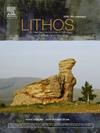Supergene formation of sulfur-rich, tochilinite-bearing serpentinites in the Oman ophiolite
IF 2.9
2区 地球科学
Q2 GEOCHEMISTRY & GEOPHYSICS
引用次数: 0
Abstract
Mass transfer processes between fluids and ultramafic rocks produce subsurface environments encompassing a wide range of redox conditions. A notable locality where an extensive range of redox conditions is observed in one location is Hole BA1B, a ∼ 400 m borehole drilled by the Oman Drilling Project. A sulfur-enriched serpentinite zone, containing up to 0.6 wt% S, occurs between shallow oxidized serpentinites (<30 m) and deep partially serpentinized harzburgite (>150 m). All three alteration zones are predominantly composed of serpentine. However, microanalysis of samples from the sulfur-enriched zone shows that mesh textures after olivine are composed of serpentine, brucite, and tochilinite mixtures, yielding optically black thin-section samples that characterize this sulfidic zone. It is proposed that sulfur accumulates in this zone via a process similar to those found in supergene ore deposits. Reaction-path models show that at shallow conditions open to atmospheric input, sulfur is mobilized via oxidative weathering of serpentinized dunite and harzburgite. Sulfate-bearing fluids percolate deeper and react with host rocks in a system closed to atmospheric input. As fluids become more reduced, dissolved sulfate is precipitated as sulfide minerals yielding rocks with ∼0.4 wt% S, like those observed in Hole BA1B. Despite enrichment of S in the sulfidic zone in Hole BA1B, Ni and Co contents are uniform throughout all three layers in the borehole. This is consistent with model results which show that Ni (and, by analogy, Co) is less mobile than S, and can be hosted in serpentine and NiFe alloys in addition to sulfides. The sulfur enrichment process may occur abiotically. However, sulfide enrichment via microbial reduction of sulfate and other sulfur species can also facilitate the formation of the sulfidic zone. Bioenergetic calculations show that abundant energy is available for sulfur reducing microbes, consistent with previous work demonstrating the presence of active, sulfate-reducing microorganisms in Hole BA1B and other nearby boreholes. This suggests that the observed sulfur enrichment is an ongoing process. Overall, this work shows that variable redox conditions are attained as fluids percolate and react with serpentinized ultramafic rocks at variable extents of interaction between aquifer fluids, host ultramafic rocks, and the atmosphere.
阿曼蛇绿岩中富含硫磺、含托起石的蛇绿岩的超成因形成
流体和超基性岩之间的传质过程产生了包含多种氧化还原条件的地下环境。阿曼钻探项目钻探的一个长约 400 米的钻孔 BA1B 是在同一地点观测到多种氧化还原条件的一个显著地点。在浅层氧化蛇绿岩(30 米)和深层部分蛇绿岩化的哈兹堡岩(150 米)之间有一个富含硫的蛇绿岩区,S 含量高达 0.6 wt%。这三个蚀变带都主要由蛇纹石组成。然而,对硫富集区样品的显微分析表明,橄榄石之后的网状纹理是由蛇纹石、青金石和托氏石混合物组成的,产生的光学黑色薄片样品是这一硫化物区的特征。据推测,硫在这一区域的积累过程与超生矿床中的过程类似。反应路径模型显示,在大气输入的浅层条件下,硫是通过蛇纹石化的云英岩和哈兹堡垒岩的氧化风化作用而被动员起来的。含硫流体渗入更深的地方,在一个封闭的大气输入系统中与主岩发生反应。随着流体变得更加还原,溶解的硫酸盐以硫化物矿物的形式沉淀下来,形成S含量在0.4 wt%以下的岩石,如在BA1B孔观察到的岩石。尽管BA1B钻孔的硫酸盐化带富含S,但钻孔中所有三层的Ni和Co含量是一致的。这与模型结果是一致的,模型结果表明,镍(以及类比的钴)的流动性比硫小,除了硫化物之外,还可能赋存于蛇纹石和镍铁合金中。硫的富集过程可能是非生物发生的。不过,通过微生物还原硫酸盐和其他硫种来富集硫化物,也可促进硫化物区的形成。生物能计算显示,硫还原微生物可以获得丰富的能量,这与之前的研究结果一致,即在 BA1B 孔和附近的其他钻孔中存在活跃的硫酸盐还原微生物。这表明观测到的硫富集是一个持续的过程。总之,这项工作表明,在含水层流体、寄主超基性岩和大气之间的相互作用程度不同的情况下,流体渗入并与蛇纹岩化超基性岩发生反应时,会产生不同的氧化还原条件。
本文章由计算机程序翻译,如有差异,请以英文原文为准。
求助全文
约1分钟内获得全文
求助全文
来源期刊

Lithos
地学-地球化学与地球物理
CiteScore
6.80
自引率
11.40%
发文量
286
审稿时长
3.5 months
期刊介绍:
Lithos publishes original research papers on the petrology, geochemistry and petrogenesis of igneous and metamorphic rocks. Papers on mineralogy/mineral physics related to petrology and petrogenetic problems are also welcomed.
 求助内容:
求助内容: 应助结果提醒方式:
应助结果提醒方式:


